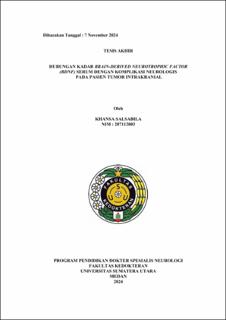Hubungan Kadar Brain-Derived Neurotrophic Factor (BDNF) Serum dengan Komplikasi Neurologis pada Pasien Tumor Intrakranial
The Association of Serum Brain-Derived Neurotrophic Factor (BDNF) Levels with Neurological Complications in Intracranial Tumor Patients

Date
2024Author
Salsabila, Khansa
Advisor(s)
Nasution, Irina Kemala
Fitri, Fasihah Irfani
Metadata
Show full item recordAbstract
Background: Brain-Derived Neurotrophic Factor (BDNF) is a neurotrophic
substance that plays an important role in maintaining neuronal survival,
differentiation, and synaptic plasticity. Evidence suggests that BDNF deficits are
interconnected with many neurological diseases including intracranial tumors. In
the study, BDNF levels were found to influence the incidence of delirium and
seizures in patients with intracranial tumors.
Objective: To determine the relationship between serum Brain-Derived
Neurotrophic Factor (BDNF) levels with neurological complications in
intracranial tumor patients at Adam Malik Hospital, Medan
Method: This study used a cross sectional design. Research subjects were
sufferers of intracranial tumors at Adam Malik Hospital in Medan during August
- October 2024 who met the inclusion criteria. Measurement of BDNF levels is
obtained from patient blood samples. Delirium was assessed using the Confusion
Assessment Method (CAM) questionnaire and seizures were observed during
treatment. Data analysis used One Way Anova and Post Hoc Games-Howell
tests.
Results: Of the 50 research subjects, the majority were women (58%), Average
age was 50.56 years. The highest education level was high school (44%), the most
common occupation was a housewife (38%) and the most common type of
intracranial tumor was primary brain tumor (54%). The most common
complication was delirium (32%). Based on the One Way Anova test, there is a
relationship between Brain-Derived Neurotrophic Factor (BDNF) levels and
neurological complications in patients with intracranial tumors (p<0.001). Based
on the Post Hoc Games-Howell test, there was a significant difference between
groups (p<0.001) but in the seizure group and the group without delirium and
seizures there was no significant difference (p>0.05).
Conclusion: There is a relationship between Brain-Derived Neurotrophic Factor
(BDNF) levels and neurological complications in the form of delirium in patients
with intracranial tumors.
Collections
- Master Theses [156]
